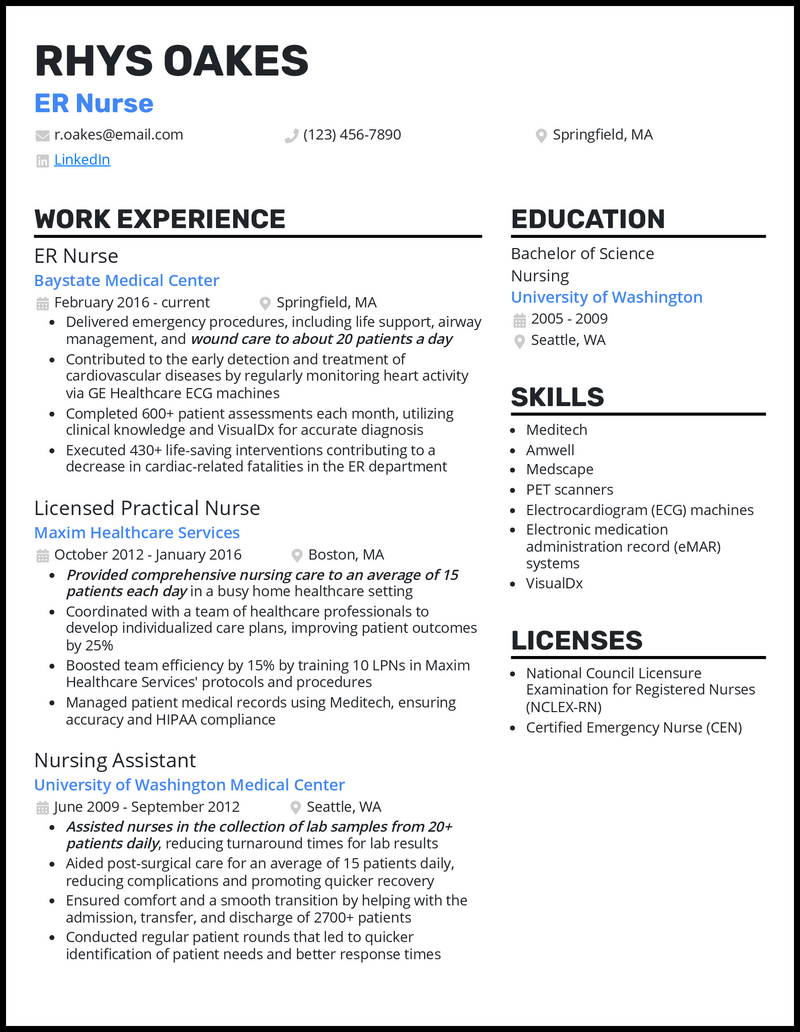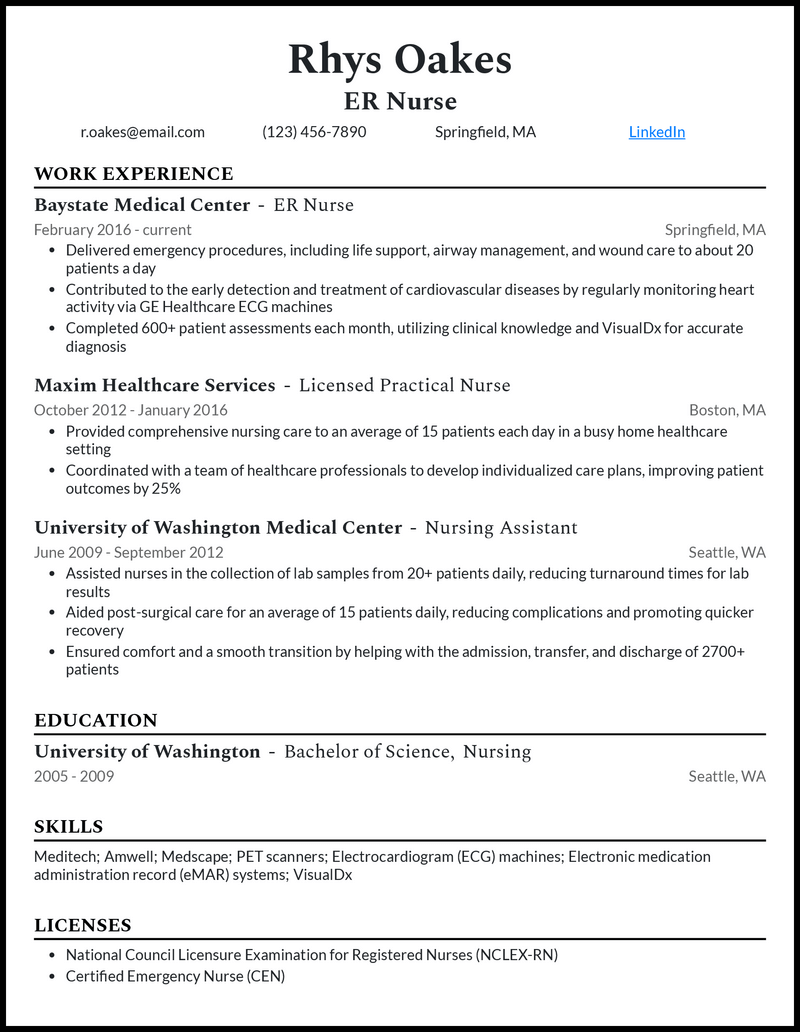As an ER nurse, you’re ready to help however you’re needed in high-key medical situations. You regularly treat patients in life-threatening situations, caring for severe wounds and ailments.
But how can you create a resume that’ll pave the way for you to step into your next ER nursing role? What resume template works best for you, and which skills do you emphasize—accurate patient documentation or fast response time in the emergency room?
Don’t worry! We’ve helped plenty of medical professionals over the years, and we’ve put together three ER nurse resume examples that can help you, too.
Why this resume works
- We get it; pulling patients from the brink is your strength. However, it will take more than your heroics to turn heads at your target company. A customized ER nurse resume that screams your pertinent qualifications comes in handy.
- One of our recommendations? Part of your resume’s side column should sparkle with your licenses and certifications (cue NCLEX-RN and CEN). That won’t just tick boxes—it strategically boosts your credibility and appeal, earning you an edge over less qualified competitors.
Related resume examples
What Matters Most: Your Skills & Work Experience Sections

Your skills section is the best spot to give recruiters a super-quick overview of which abilities qualify you to work in the emergency room. It’s time to think of what sets you apart as an ER nurse, whether you have flawless active listening skills or a unique specialization in emergency operations.
You’ll want to balance your resume between hard and soft skills according to the job description—but maintain a technical feel while you do it. List skills specifically.
That means specific both to your job role in the ER, and to the skill itself. Don’t write “calendar software” if you mean Google Calendar in particular! And avoid generic terms like “note taking” when you could specify “patient procedure notes”.
See what we mean:
9 top ER nurse skills
- CPR
- Multitasking
- Adaptability
- Medscape
- PET Scanners
- VisualDX
- Patient Vitals
- Injury Assessment
- Triage Care
Sample ER nurse work experience bullet points
Your job may also be referred to as “critical care nurse,” which gives some more insight into what to add to your resume. Recruiters need to see that you’ve already experienced an array of tasks that make you a better ER Nurse. One day you could work with geriatric patients, while a day later you’ll be helping a disabled child.
Adaptability and a cool head or “calming attitude” are often underrated, but you’ll want to focus on traits like these as context for your experience points. Success stories that demonstrate your ability to perform life-saving procedures and triage care.
With each story you tell about what you did, why you did it, and how, include a metric. You’ll want to have quantifiable data to show what kind of a positive impact you had: Recovery rates, percentages, and reduced wait times.
Here are some samples:
- Coordinated with a team of healthcare professionals to develop individualized care plans, improving patient outcomes by 26%
- Boosted team efficiency by 15% by training 10 LPNs in Maxim Healthcare Services’ protocols and procedures
- Delivered emergency procedures, including life support, airway management, and wound care to aboit 20 patients a day, surpassing employee expectations by 9%
- Assisted 32 patients with personal care such as bathing, oral hygiene, shaving, and hair care, improving personal care provider rating to 4.9/5 stars

How to Add Certifications to ER Nurse Resumes
When you’re tasked with treating life-threatening conditions at a moment’s notice, the right specialties can make all the difference. Therefore, adding some certifications to your ER Nurse resume that show you have specialized knowledge will help you stand out in the hiring process.
To add a certifications section, put it below your nursing education and skills sections. Each certificate you list should include:
- The name of the certification, such as Certified Emergency Nurse
- The organization you received it from, such as the American Red Cross
- The date you received it
- The certificate’s expiration date (if applicable)

The best certifications for ER nurse resumes
There’s no shortage of nursing certifications you could gain throughout your career, so choosing the right ones can feel challenging. Aim to include certifications that are relevant to the role you’re applying to. For example, an advanced cardiovascular life support certificate would be ideal if a hospital is seeking nurses with cardiovascular knowledge.
Here are some of the top ER nurse certifications in the healthcare industry:
- Basic Life Support (BLS): A BLS certificate is an excellent choice for ER nurses because it shows essential abilities in CPR, using defibrillators, and crisis response.
- Certified Emergency Nurse (CEN): A CEN is a well-rounded option for those looking to work in an ER environment. It’ll show hiring managers you’re knowledgeable in rapid response, wound care, and trauma response.
- Informatics Nursing Certification: Do you want to show your capabilities with technical nursing equipment? An informatics nursing certificate shows you can handle PET scanners, ECGs, and ventilators.
Some other top certifications for ER nurses are:
Top 5 Tips for Your ER Nurse Resume
- Highlight your efficiency
- You’re always on the go while helping patients, and time is of the essence in emergency situations. Recruiters need to see that, from the moment a patient enters your emergency room, you’re able to provide the general medical assistance (or special case support) they need.
- Switch up your context
- Including a variety of contextual details to set off each of your experiences can enrich your ER nurse resume. While variance in metric types is good, just a few words of backstory can breathe extra life into your point.
- Streamline your template
- Just as your response to each crisis in the ER must be lightning-fast, your work experience bullet points should be similarly sleek and optimized. Recruiters don’t have much time to spare, so introduce your stories of improved patient discharge and satisfaction rates efficiently, keeping other details concise!
- Enhance your skills with good metrics
- That’s right: Not all metrics are the same quality! Random headcounts or ER cases aren’t as impressive on their own as they are when they boost a final point like an improvement in recovery percentages or personal ratings.
- Keep things minimal
- It’s tempting to spruce up your resume with colors and fancy fonts, but you want to opt for as sleek and modern of a look as you can. Think of how clean the medical setting looks, and convey that with super understated colors and plain fonts.
Stick with a one-page resume! Just as you tend to scan medical forms quickly with your detail-oriented eye, recruiters skim resumes in search of qualifications or details that jump out at them. Two pages feels more like a “long read” than a “skim,” making your resume less desirable!
These are more of a “cover letter thing,” but it’s a great idea either way! Write a cover letter and address any additional attachments like certificates or licenses to your application package.
Any really good experience points that overflow your resume can really shine in a cover letter. Refer to the time you helped revamp a senior care educational program that prevented slips and falls by 8% among participants!




![3 ER Nurse Resume Examples [& Templates]](https://beamjobs.wpenginepowered.com/wp-content/uploads/2023/05/er-nurse-standout-resume-example.png)



